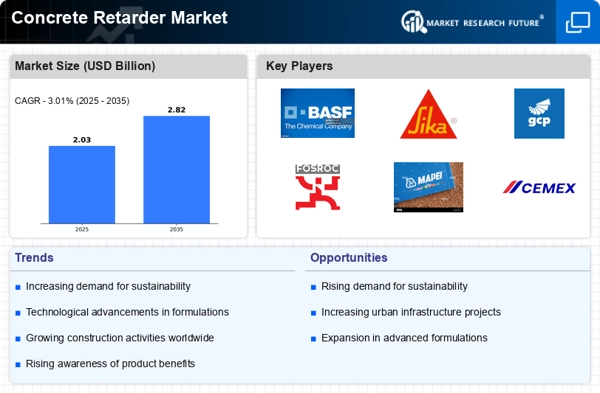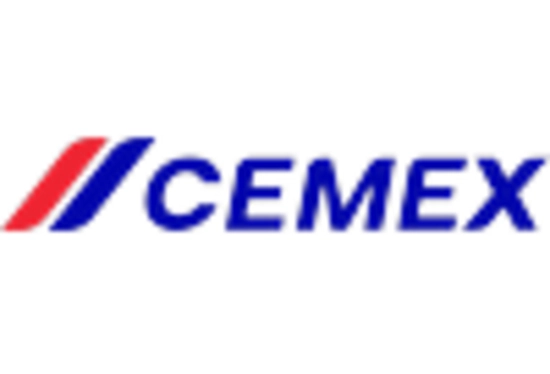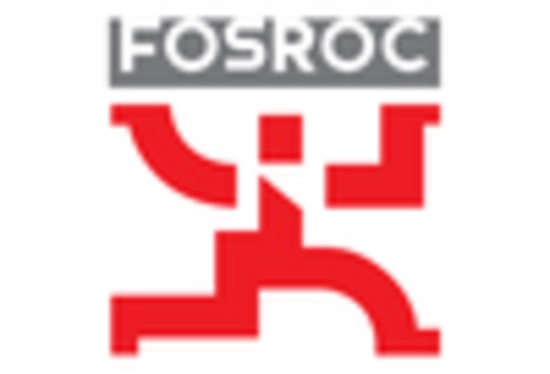Rising Construction Activities
The Concrete Retarder Market is experiencing a surge in demand due to increasing construction activities across various sectors. As urbanization accelerates, the need for residential, commercial, and infrastructure projects intensifies. In 2025, the construction sector is projected to grow at a rate of approximately 5.5% annually, driving the consumption of concrete retarders. These additives are essential for managing the setting time of concrete, particularly in large-scale projects where delays can lead to significant cost overruns. Consequently, the rising number of construction projects is likely to bolster the Concrete Retarder Market, as contractors seek to optimize their operations and ensure quality in their concrete mixes.
Regulatory Standards and Compliance
The Concrete Retarder Market is increasingly influenced by regulatory standards and compliance requirements. Governments and regulatory bodies are implementing stringent guidelines to ensure the safety and sustainability of construction materials. These regulations often mandate the use of specific additives, including concrete retarders, to enhance the performance and longevity of concrete structures. As a result, manufacturers are compelled to innovate and develop products that meet these evolving standards. In 2025, it is anticipated that compliance with environmental regulations will drive the demand for eco-friendly concrete retarders, thereby shaping the market landscape. This regulatory environment is likely to create opportunities for growth within the Concrete Retarder Market.
Increased Demand for High-Performance Concrete
The Concrete Retarder Market is witnessing a notable increase in demand for high-performance concrete (HPC). This trend is driven by the need for materials that can withstand extreme conditions and provide enhanced structural integrity. HPC applications are prevalent in sectors such as bridges, highways, and high-rise buildings, where the quality of concrete is paramount. The market for high-performance concrete is expected to grow at a compound annual growth rate (CAGR) of around 6% through 2025, which will likely elevate the demand for concrete retarders that facilitate the production of such specialized mixes. As construction professionals seek to meet stringent performance standards, the Concrete Retarder Market stands to gain from this heightened focus on quality.
Technological Innovations in Concrete Chemistry
Innovations in concrete chemistry are playing a pivotal role in shaping the Concrete Retarder Market. The development of advanced retarding agents that enhance the performance of concrete is becoming increasingly prevalent. These innovations not only improve the workability and durability of concrete but also address environmental concerns by reducing the carbon footprint associated with traditional concrete production. In 2025, it is estimated that the market for eco-friendly concrete additives, including retarders, will expand significantly, reflecting a growing preference for sustainable construction practices. As a result, the Concrete Retarder Market is likely to benefit from these technological advancements, which may lead to the introduction of more efficient and effective retarding solutions.
Growing Focus on Sustainable Construction Practices
The Concrete Retarder Market is experiencing a paradigm shift towards sustainable construction practices. As environmental concerns gain prominence, builders and contractors are increasingly seeking materials that minimize ecological impact. Concrete retarders that are derived from renewable resources or that enhance the recyclability of concrete are becoming more desirable. In 2025, the market for sustainable construction materials is projected to expand significantly, with concrete retarders playing a crucial role in this transition. This growing focus on sustainability is likely to drive innovation within the Concrete Retarder Market, as manufacturers strive to develop products that align with the principles of green building and sustainable development.


















Leave a Comment